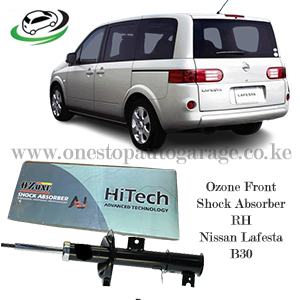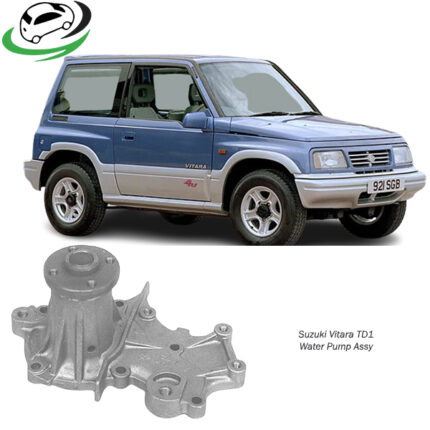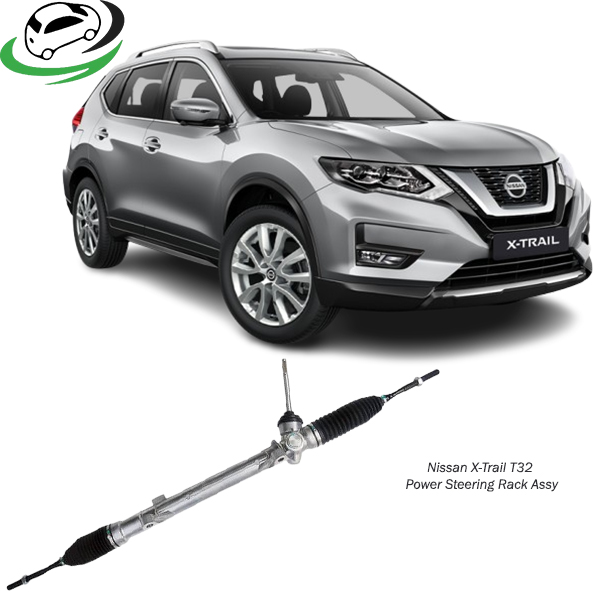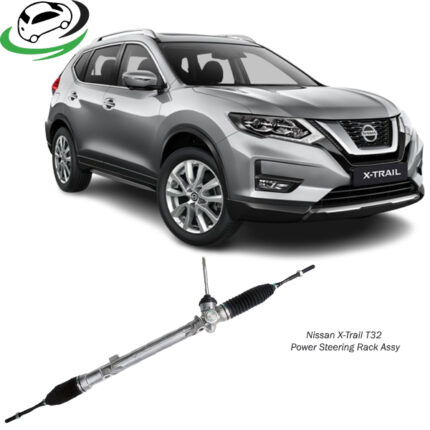-7%
Get Nissan X-Trail T32 Power Steering Rack Assy 48001-4BG0A in Kenya
The power steering rack assembly is a crucial component in modern vehicles, responsible for making steering easier and more responsive. This assembly consists of several parts that work together to amplify the driver’s steering input, allowing for smoother and more effortless control of the vehicle. Here’s an in-depth look at the power steering rack assembly, its components, functions, types, and common issues.
Components of Power Steering Rack Assembly
- Steering Rack and Pinion:
- Rack: A linear gear connected to the steering wheel via the steering shaft. It converts rotational motion into linear motion to turn the wheels.
- Pinion: A small, round gear attached to the steering shaft. When the steering wheel is turned, the pinion rotates and moves the rack.
- Hydraulic Cylinder:
- Located on the rack, it uses hydraulic fluid to assist in moving the rack when the steering wheel is turned.
- Tie Rods:
- Connected to both ends of the rack, these rods transmit the steering force to the wheels.
- Power Steering Pump:
- A hydraulic pump driven by the engine that supplies pressurized fluid to the hydraulic cylinder.
- Hydraulic Fluid:
- Special fluid that transfers the hydraulic pressure from the pump to the cylinder, providing the necessary force to assist in steering.
- Pressure and Return Hoses:
- These hoses carry the hydraulic fluid between the pump and the steering rack.
- Control Valve:
- Regulates the amount of hydraulic fluid sent to the cylinder based on the steering input.
How It Works
The power steering system operates by using hydraulic or electric power to assist the driver in turning the steering wheel. Here’s a step-by-step explanation of how it works:
- Steering Input:
- When the driver turns the steering wheel, the motion is transmitted to the pinion gear via the steering shaft.
- Rack Movement:
- The pinion gear, meshed with the steering rack, moves the rack in a linear direction corresponding to the rotation of the steering wheel.
- Hydraulic Assistance:
- As the rack moves, the control valve directs pressurized hydraulic fluid to one side of the hydraulic cylinder.
- The hydraulic fluid helps push the rack, reducing the effort needed by the driver to turn the wheel.
- Wheel Turn:
- The movement of the rack is transferred to the tie rods, which then push or pull the wheels, causing them to turn.
Types of Power Steering Systems
- Hydraulic Power Steering (HPS):
- Utilizes hydraulic pressure generated by the power steering pump to assist in steering. It is the most traditional form of power steering.
- Electric Power Steering (EPS):
- Uses an electric motor to assist in steering instead of hydraulic fluid. It’s more energy-efficient and often found in modern vehicles.
- Electro-Hydraulic Power Steering (EHPS):
- A hybrid system that combines hydraulic and electric components. An electric motor drives the hydraulic pump, providing the benefits of both systems.
Advantages of Power Steering Assy:
1. Reduced Effort
Mechanism
Power steering systems, whether hydraulic, electric, or electro-hydraulic, are designed to amplify the driver’s input, thereby reducing the physical effort required to turn the steering wheel.
Benefits
- Ease of Operation: Especially noticeable during low-speed maneuvers, such as parking or navigating tight spaces, where steering can be physically demanding.
- Accessibility: Makes driving more accessible to a broader range of people, including those with less physical strength, such as elderly drivers or those with certain disabilities.
2. Enhanced Maneuverability
Mechanism
The power steering system provides additional force to assist in steering, enabling more precise and responsive handling of the vehicle.
Benefits
- Improved Control: Drivers can more easily make quick adjustments, which is particularly beneficial in emergency situations or when navigating winding roads.
- Parking and Low-Speed Driving: Maneuvering in tight spaces becomes less cumbersome, making parallel parking and other challenging parking tasks more manageable.
3. Increased Safety
Mechanism
Power steering allows for faster and more accurate steering responses, contributing to better vehicle control.
Benefits
- Quick Response: Enhanced responsiveness can be critical in avoiding obstacles and reacting to sudden changes in traffic conditions.
- Steering Precision: Allows for more precise steering inputs, which is crucial for maintaining control in adverse weather conditions or on slippery roads.
- Fatigue Reduction: Reduces driver fatigue on long journeys, thereby improving concentration and reducing the likelihood of accidents caused by driver error.
4. Driver Comfort
Mechanism
The power steering system absorbs much of the resistance encountered when turning the wheels, providing a smoother and more comfortable driving experience.
Benefits
- Less Physical Strain: Significantly reduces the physical effort required to steer, preventing muscle fatigue and strain, especially during long drives or repetitive steering tasks.
- Smoother Ride: Contributes to an overall smoother ride, as the steering system helps to cushion the driver from road shocks and vibrations transmitted through the wheels.
5. Fuel Efficiency and Environmental Impact
Mechanism
Modern power steering systems, particularly electric power steering (EPS) and electro-hydraulic systems, are designed to be more energy-efficient than traditional hydraulic systems.
Benefits
- Fuel Economy: EPS systems, for instance, only consume energy when steering assistance is needed, whereas traditional hydraulic systems can drain engine power continuously.
- Reduced Emissions: Improved fuel efficiency translates to lower greenhouse gas emissions, contributing to a reduced environmental footprint.
6. Longevity of Steering Components
Mechanism
Power steering systems help reduce the load and stress on the steering components, potentially extending their lifespan.
Benefits
- Less Wear and Tear: By assisting with the steering load, these systems can reduce the mechanical wear on components such as the steering rack, pinion, and tie rods.
- Maintenance Savings: Potentially lowers maintenance costs over the vehicle’s lifetime by reducing the frequency of necessary repairs and replacements of steering components.
7. Technological Integration
Mechanism
Modern power steering systems, particularly EPS, integrate seamlessly with advanced driver-assistance systems (ADAS) and other automotive technologies.
Benefits
- Enhanced Features: EPS systems can be integrated with features like lane-keeping assist, automatic parking, and adaptive cruise control, enhancing overall vehicle safety and convenience.
- Smart Steering: Some advanced systems can adapt to driving conditions and provide variable steering assistance, offering more help at low speeds and a firmer feel at higher speeds for better control.
8. Customizable Steering Feel
Mechanism
Many modern vehicles equipped with electric power steering offer customizable settings that allow drivers to adjust the steering feel according to their preference.
Benefits
- Driver Preferences: Allows drivers to choose between different modes, such as comfort, normal, or sport, depending on their driving style and conditions.
- Adaptive Response: Systems can adapt to different driving conditions, providing a lighter steering feel for city driving and a heavier, more controlled feel for highway driving.
9. Reduced Noise and Vibration
Mechanism
Electric power steering systems, in particular, tend to operate more quietly and smoothly compared to traditional hydraulic systems.
Benefits
- Quieter Operation: Reduced operational noise contributes to a quieter cabin environment, enhancing overall driving comfort.
- Smoothness: Less vibration and smoother steering operation improve the driving experience, particularly in premium and luxury vehicles.
Signs of worn out Power Steering Assy:
1. Difficulty Steering
Signs:
- Increased Effort: Steering requires more physical effort, especially at low speeds or while parking.
- Stiff Steering Wheel: The steering wheel feels stiff or resistant when trying to turn it.
Causes:
- Low Hydraulic Fluid: Could indicate a leak or insufficient fluid levels.
- Worn Steering Rack: Internal components of the rack may be damaged or worn out.
- Faulty Pump: The power steering pump may be failing to provide adequate pressure.
2. Noisy Steering
Signs:
- Whining or Squealing: A high-pitched whining or squealing noise when turning the steering wheel.
- Grinding or Clunking: Unusual grinding or clunking sounds, especially when making sharp turns.
Causes:
- Air in the System: Air bubbles can cause whining noises, often due to a leak.
- Worn Pump: The power steering pump might be on the verge of failure.
- Loose or Damaged Components: Tie rods, steering rack mounts, or other parts may be loose or damaged.
3. Fluid Leaks
Signs:
- Puddles or Spots: Presence of reddish or amber-colored fluid under the vehicle.
- Low Fluid Levels: Frequent need to top up the power steering fluid.
Causes:
- Damaged Hoses: Pressure or return hoses might be cracked or worn.
- Faulty Seals: Seals within the steering rack or pump can degrade over time.
- Leaking Connections: Loose or damaged fittings and connections in the hydraulic system.
4. Vibration or Jerking in Steering Wheel
Signs:
- Steering Wheel Vibration: Noticeable vibrations in the steering wheel, especially when turning.
- Jerking Movements: Intermittent jerking or pulsating feeling when steering.
Causes:
- Worn Components: Worn or damaged steering rack or tie rods.
- Contaminated Fluid: Dirty or contaminated power steering fluid can affect the system’s performance.
- Pump Issues: A failing pump might cause inconsistent hydraulic pressure.
5. Steering Wheel Does Not Return to Center
Signs:
- Delayed Return: The steering wheel does not return to the center position smoothly after making a turn.
- Requires Manual Correction: The driver needs to manually help the steering wheel return to the center.
Causes:
- Worn Rack and Pinion: Damage or wear in the rack and pinion gears can affect the system’s return function.
- Binding in the System: Internal binding due to wear or damage in the steering assembly.
6. Loose Steering Feel
Signs:
- Play in Steering: Excessive play or looseness in the steering wheel.
- Wandering: The vehicle tends to drift or wander, requiring constant corrections.
Causes:
- Worn Tie Rods: Loose or worn tie rods can cause a loose steering feel.
- Steering Rack Wear: Wear in the steering rack can lead to imprecise steering control.
7. Check Engine Light or Power Steering Warning Light
Signs:
- Dashboard Warning Lights: The appearance of the check engine light or a specific power steering warning light.
Causes:
- Sensor Issues: Faulty sensors in the power steering system.
- System Malfunction: Various malfunctions within the power steering system, prompting the vehicle’s diagnostic system to alert the driver.
8. Unusual Tire Wear
Signs:
- Uneven Tire Wear: Tires show uneven wear patterns, particularly on the edges.
Causes:
- Misalignment: A worn power steering rack can lead to improper wheel alignment.
- Suspension Issues: Related suspension components might also be affected.
9. Burning Smell
Signs:
- Burnt Odor: A burning smell coming from the engine bay, particularly when steering.
Causes:
- Overheated Fluid: Overheating of the power steering fluid due to pump failure or excessive friction within the system.
- Belt Slippage: A slipping drive belt causing excessive heat and burning smell.
Follow us on Facebook for more parts.




